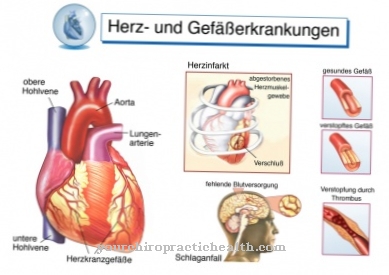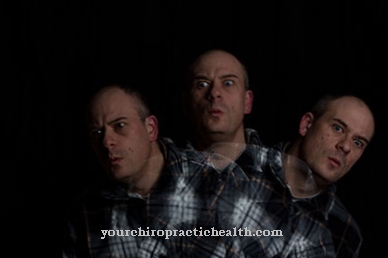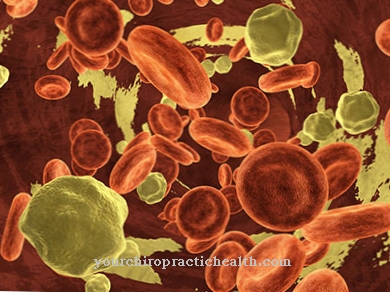At a Motility disorder it is a disorder of the digestive organs. Their physiological movement processes do not proceed as in healthy people, which is why digestion is disturbed. The term motility disorders is understood to mean numerous different disorders of the digestive processes.
What is motility disorder?

© martialred - stock.adobe.com
To understand Motility disorders Knowledge of the structure of the digestive tract is essential. The digestive tract has a special type of musculature along its entire length. These muscles are smooth and are located in the wall of the tract. Since motility disorders are fundamentally related to this smooth type of muscle, almost all sections of the digestive tract can be affected by the motility disorders.
These include, for example, the stomach, esophagus, duodenum, small intestine, colon and rectum. From a clinical point of view, the stomach, esophagus, colon and rectum are particularly affected by motility disorders. Since motility disorders are very diverse, there are different ways of categorizing the disorders.
For example, it is possible to classify the diseases according to the type of disorder. This classification is based on the fact that motility disorders can arise from both reduced and increased motility. Accordingly, a distinction is made between hypomotility, which comes about through reduced movements of the muscles, and hypermotility with increased activity.
Motility disorders can also be divided according to the cause of the disorder. The so-called primary motility disorders are an independent disease phenomenon. Secondary motility disorders, on the other hand, are secondary disorders that result from other underlying diseases.
causes
The exact cause of each motility disorder differs from case to case and also depends on which section of the digestive tract is affected by the disorder. In principle, all motility disorders and the associated symptoms and complaints are triggered by abnormal contractions of the muscles. These muscles are located along the digestive tract, starting at the esophagus and running to the rectum.
In principle, motility disorders are relatively widespread in the population. However, in the majority of cases they are comparatively harmless and usually do not pose a serious threat to the life of the patient concerned. Nevertheless, they are perceived as annoying by numerous sick people and sometimes impair the individual quality of life.
On the other hand, there are also forms of motility disorders that, due to their severity and severity, urgently require medical therapy. Because if the symptoms of motility disorder are not treated, the worst case scenario is the death of the affected patient, as in some cases life-threatening complications arise.
Symptoms, ailments & signs
Basically, the term 'gastrointestinal motility disorders' includes specific types of movement disorders of the digestive tract that lead to a number of different symptoms and ailments. These symptoms differ depending on the patient and the severity of the disorders.
Motility disorders occur either singly or in multiple sections of the gastrointestinal tract. They affect the esophagus, the large or small intestine and the stomach, for example. In some cases, the motility disorders trigger only mild symptoms, in other cases they lead to long-lasting and threatening symptoms. The motility disorders are based either on a reduced movement of the muscles, in which the muscles are partially paralyzed.
On the other hand, there is the possibility that the muscles of the digestive tract are working too hard and often move in an uncoordinated manner. Symptoms vary greatly depending on which part of the gastrointestinal tract is affected. Possible clinical pictures are, for example, achalasia, gastroparesis, functional dyspepsia (or so-called irritable stomach), irritable bowel syndrome and chronic intestinal pseudo-obstruction.
Diagnosis & course of disease
With regard to the diagnosis of motility disorders, there are various possibilities and examination methods.Basically, in the majority of cases it is relatively time-consuming to reliably diagnose motility disorders. Because a pictorial representation of the digestive tract alone is not sufficient, since it is primarily about the functional investigation of movements of the intestine or other areas of the digestive tract.
In many cases, so-called manometry is used. However, this is only suitable for certain sections of the digestive tract. Esophageal manometry examines the esophagus, while antroduodenal manometry examines the gastric outlet and duodenum. There is also the possibility of small intestine, colon and rectum manometry.
In some cases, a barostat study is also performed, which provides insight into the relationship between pressure and volume. To do this, an intraluminal balloon is inserted into the rectum. As the balloon unfolds slowly, the perception and defecation reflex of the affected patient can be examined.
In the case of fluoroscopy, a dynamic x-ray image is displayed, in which special contrast media are used. The movement behavior of individual areas of the gastrointestinal tract is examined.
Complications
As a rule, the motility disorder leads to various complaints and disorders in the stomach and intestines. This can lead to various complications and complaints, which depend heavily on the severity of the motility disorder. As a rule, however, the affected person's everyday life is significantly restricted.
It is not uncommon for the motility disorder to lead to so-called irritable bowel or irritable stomach, so that the person affected has to struggle with stomach pain or constipation even with a light diet. The permanent stomach problems can often lead to psychological complaints or even depression. An early diagnosis is not possible in many cases because the symptoms are not characteristic of the disease and can therefore be confused with other diseases.
Treatment for this disease is usually done through various drugs and therapies. As a rule, there are no particular complications and the life expectancy of the patient is not restricted by this disease. However, in many cases the person concerned also has to rely on a healthy lifestyle in order to limit the symptoms of the motility disorder. In most cases, however, the disease progresses positively.
When should you go to the doctor?
Disorders of the digestive tract should be clarified by a doctor if they persist over a longer period of time. In the case of one-off impairments, there may be short-term digestive disorders that subside through the self-healing mechanism of the organism. In the event of persistent disorders, the cause must be clarified so that treatment can take place and the symptoms can be alleviated. If the irregularities occur immediately after the intake of food, the reason may be intolerance to ingested food.
Persistent emotional or emotional stress and stressful living conditions are also possible causes of the motility disorder. In a conversation with the doctor, possible influencing factors are discussed and narrowed down. If the person concerned suffers from an irritable stomach, noise in the stomach or intestines and diffuse pain, a doctor is needed.
If flatulence, diarrhea or constipation occur over several days or weeks, these should be examined and treated. Loss of appetite, sluggishness, increased tiredness and exhaustion indicate health disorders that should be clarified by a doctor. Signs such as paralysis of the muscles, restricted mobility and a loss of the usual ability to perform and concentrate are worrying. If the everyday requirements can no longer be met as usual, the person concerned needs help. If there are circulatory disorders, a general feeling of illness or sleep disorders, a doctor should be consulted.
Treatment & Therapy
The treatment of motility disorders depends primarily on the individual severity of the disorder. On the one hand, there is the possibility of dietary measures that may have a positive influence on the digestive tract. Various drugs are also available, for example prokinetics. In severe cases, invasive therapy methods are necessary.
You can find your medication here
➔ Medication for diarrheaOutlook & forecast
The prospect depends on the extent and cause of the disease. In most cases, a motility disorder can be fixed with simple means. Most of the time, just following a diet is enough to relieve the symptoms. In other cases, taking medication leads to a cure. Medicines themselves can sometimes cause a motility disorder. Then a substitute for the active ingredients has to be found. These measures usually promise recovery. Some of them can also be carried out by the patient himself. This results in a good prognosis that can be achieved with simple means.
Motility disorders rarely lead to a reduction in quality of life. This is the case when the measures described do not lead to success. Invasive interventions then become necessary. If patients forego therapy in such a severe course, stomach paralysis or intestinal obstruction are the result. This results in a high risk that has an impact on life. Certain diseases such as food allergies, diabetes, a disease of the nervous system and an underactive thyroid make it more severe. The prospect then deteriorates accordingly.
prevention
There are many potential measures to prevent motility disorders. Basically, a healthy lifestyle with a balanced diet and exercise contribute to the normal functioning of the digestive tract.
Aftercare
In most cases, there are no special or direct follow-up measures available to the person affected by the motility disorder, so that the person affected should first and foremost consult a doctor very quickly and above all at an early stage. As a rule, there is also no independent healing, so that a quick diagnosis and subsequent treatment by a doctor is always necessary.
Usually, the motility disorder can be treated relatively well with a strict diet. The doctor can also create a nutrition plan for the person concerned. In general, it is important to follow a healthy lifestyle with a balanced diet with this disease, avoiding alcohol and tobacco. The use of various medications can also alleviate and limit the symptoms of motility disorder.
The person affected should ensure the correct dosage and regular intake of the medication. Regular checks by a doctor are also very important. In most cases this disease does not reduce the life expectancy of the person affected, although the further course depends very much on the time of diagnosis, so that a general prediction is usually not possible.
You can do that yourself
The measures that those affected can take in the event of a motility disorder primarily depend on the type and severity of the disorder. In general, diet changes can improve gastrointestinal health. Patients should avoid irritating foods and stimulants and instead include more digestive foods and drinks on the menu.
In conjunction with a well-controlled medication, the symptoms can be effectively alleviated. In severe cases, however, surgery is required. Since interventions on the gastrointestinal tract pose a great risk for the patient, close monitoring by the doctor is necessary. In addition, attention should be paid to any accompanying symptoms or unusual complaints. If, for example, bleeding or severe pain occurs after an operation, the responsible doctor must be informed.
Basically, rest is important after a surgical procedure. Especially in the first days and weeks after the operation, the body and especially the gastrointestinal tract must not be overburdened. The doctor's specifications regarding diet, hygiene measures and restraint must always be observed. Otherwise, serious complications can arise and delay the healing process.


.jpg)

.jpg)








.jpg)

.jpg)











.jpg)